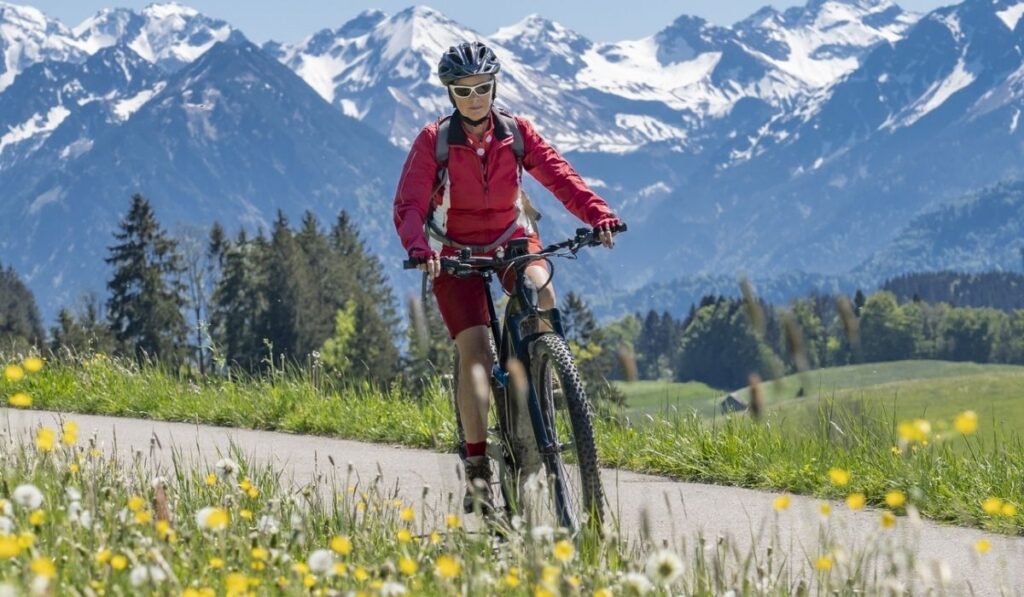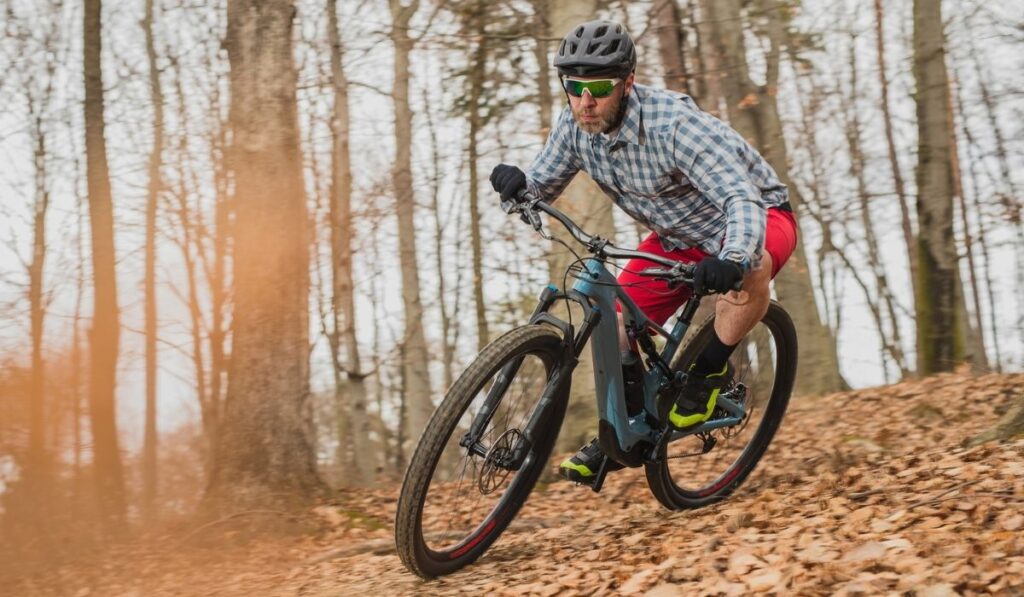Electric bikes are still relatively new in the riding scene and are rapidly gaining popularity. Because of this, there has been much controversy on whether or not they should be allowed on trails, with some areas of the country handling the issue differently than others.
While some think E-Bikes damage trails with their faster acceleration, the damage is no more than that from normal mountain bikes. If users follow proper trail etiquette and act responsibly, E-Bikes can be safe for trail use, but always check the rules for the specific trail you’re riding on.
So we all know that following proper riding etiquette is crucial to your safety and everyone else’s. But what is adequate trail etiquette? Where can you ride e-bikes on trails, and where should you? Read on for more information!
Where are E-Bikes Allowed

The regulations that state the places you can legally ride e-bikes are hazy, confusing, and change largely based on your location. Different states have different rules based on their varying definitions and classifications of e-bikes and relevant restrictions. Confusing, right? On top of that, the federal guidelines can differ from the states, adding to the confusion.
As of 2019, E-MTBs and e-bikes are allowed in national parks. Parks run by the Bureau of Land Management (BLM), National Park Service (NPS), Fish and Wildlife Service, and Bureau of Reclamation allow entry to Class 1 and Class 2 e-bikes (up to 750 watts).
However, the Department of The Interior is suggesting new laws and regulations that could alter this. These proposed laws may allow e-bikes on non-motorized trails, leading to much controversy.
State Regulations
Furthermore, the state’s regulations of electric bikes vary across the US. As of now, 44 states have regulations that define e-bikes in some capacity. 26 states use the three-tier class system. The remaining 18 states have varying definitions. To find your state, check this map!
Some states may allow you to ride on bike paths and sidewalks. Other states may limit electric bikes to roads, or have a fixed speed limit when using sidewalks. It all depends on your location. Be sure to check locally before riding!
As far as laws varying between e-bikes and E-MTBs, they’re nearly the same depending on your location. You’ll typically be able to ride your E-MTB wherever you can ride your electric bike. However, you may not be able to ride your E-MTB on the same trails where you can ride conventional mountain bikes.
The trails you can use an electric bike on will typically be indicated with a sign. If you don’t see a sign or you are unsure, just ask locally. You can check this with your local bike shop, or the people responsible for taking care of the trail.
Can E-Bikes Go Off-Road?
Just like conventional bicycles, electric bikes can be ridden off-road. That being said, some electric bikes are better suited for this than others. When taking an e-bike off-road, it’s better to use one with bigger tires, better suspension, and a step-over frame.
Not all electric bikes are created equal. Some bikes are better suited for city commuting, while others are meant to take on the backcountry—for example, the Heybike Cityscape Electric Bike (on Amazon). E-bikes with low step-through frames are typically not suitable for off-roading or climbing steep hills.
Bikes with low step-through frames are better suited for leisurely city commutes. The Heybike Cityscape will perform the best cruising down the beach or going to pick up groceries. This is because the low step-through frame is not as durable as other options.
What E-Bike is Good for Off-Roading?
A bike like the VELOWAVE Fat Tire Electric Bike (on Amazon) would be better suited for off-roading and climbing steeper inclines. The thicker tires give you more traction and control on rougher surfaces, and the stronger motor and battery will give you extra power and speed for rougher climbs as well. However, this is a hardtail bike, so it can’t conquer everything.
Electric bikes with full suspensions like the Eahora AM200 750W (Also on Amazon) are going to be much better suited for highly technical terrain compared to hardtails. Full-suspension e-bikes perform their best when off-roading. Compared to hardtail e-bikes, they have more control, traction, and comfort. This allows you to tackle rougher trails and environments.
This may be a bit obvious, but e-bikes like the Addmotor Motan 3 Wheel Electric Bicycle (on Amazon) will not perform well off-roading. E-bikes with three wheels are better suited for the city and leisurely commutes. These bikes are also good for the less mobile or elderly population; they definitely shouldn’t be ridden through the backcountry.
Are Mountain Bikes and E-MTBs Bad for Trails?

One of the main arguments against e-bikes is the potential damage they could cause to trails and nature. This argument has triggered many conversations around laws and regulations. However, E-MTBs seem to be just as harmful to trails as traditional mountain bikes.
One study found that Class 1 E-MTBs and traditional mountain bikes caused similar damage to trails. This study compared the amount of soil erosion/displacement Class 1 E-MTBs, traditional mountain bikes, and motorcycles caused to trails.
The results show that the damage caused by Class 1 E-MTBs and traditional bikes is near identical. In fact, the average variance between the two came out to 0.9999. Which basically means no discernable difference was measured. No surprises, though; motorcycles caused far greater damage than both these bikes.
The study may be inconclusive overall, but the results are certainly promising. When ridden responsibility, E-MTBs cause just as much damage as traditional mountain bikes. Not to mention, the damage traditional mountain bikes cause isn’t incredibly high.
That being said, the use of throttle can be more damaging to trails than traditional mountain bikes. Trails and parks have restricted the use of throttle for this reason. Now, it’s a different story if you ask if e-bikes are bad for trails socially.
Can E-MTB Riders Annoy Traditional Mountain Bikers?
The potential for e-bikes to disrupt the balance of trails is one of the reasons for their controversy. Allowing high-powered motorized bikes in nature just doesn’t sit right with some trail-goers. One of the worries is that e-bike riders will annoy mountain bikers and hikers using the trails.
This is a natural concern. Hikers and cyclists not used to higher-speed bikes could be involved in accidents. The same goes for reckless e-bike riders. So, how can electric bike users avoid potential accidents and practice good etiquette?
- Keep it Local: To practice good etiquette and figure out your community guidelines, talk to your local bike shop. Your local bike shop will have the best information on where you can ride and what you should be wary of.
- Only Ride Specially Marked Trails: Be sure to ride only on specified e-bike trails. This will ensure you aren’t breaking any guidelines, and everyone else using the trail will be prepared.
- Follow the Trail: Be sure to follow the trail, and avoid going off-route or getting lost. Going off the trail is dangerous and can lead to injury. On top of that, going off route can cause damage to the terrain around you.
- Stay off the Trail when it’s Dangerous: Heavy rainfall and other situations can make trails hazardous for riders. When you’re on an e-bike, you’ll want to be especially careful to avoid large puddles. Be sure to check locally if a trail is safe to ride and in good condition.
- Monitor your Speed: When riding your e-bike off-road, be sure to monitor your speed. Don’t go so fast that you can hurt yourself or others. Figure out the best speed for you, the trail, and your bike.
- Slow Down when Passing: When passing other trail users, slow down and let them know. Wave at them or call out, “On your right!” This will ensure that they’re aware that you’re passing by and can act accordingly.
Following these etiquette guidelines and being generally respectful will ensure everyone’s safety. It’s our duty to give e-bike riders and the sport a good name: the more kind, and respectful riders out there, the better.
How Other Trail-Goers Can Accept E-bike Riders
But, wait! Why is everyone mad at e-bike riders? Why is there no advice for traditional mountain bikers and other trail goers? We got you covered.
If you’re a traditional mountain bike rider, hiker, or even horseback rider, you can play a part in this situation too. Remember that this is a two-way street and if both groups play their role, then we can all enjoy trails safely and securely. So, what can other trail-goers do?
1. Be Accepting of E-Bikes: The first thing other trail-goers can do is be accepting of e-bikes in general. E-bike users want to enjoy the outdoors just as much as everyone else. Their use of a motorized bicycle doesn’t change this. Accept that e-bike riders are going to be using your trails and try and make friends with them.
2. Help New Riders Understand Etiquette: If there’s an e-bike rider acting a fool, let them know! The rider may not understand trail etiquette and, at worst, be a reckless rider. Either way, you should let them know and guide them to riding more responsibly.
3. Practice Good Etiquette: Now, we probably don’t have to tell you this one. Just in case, always practice good etiquette. Be kind and respectful to other trail goers. Let them know when you’re passing or behind them. The basics are essential and should always be respected!
4. Consider Purchasing an E-Bike: If you can’t beat them, join them! One of the best ways to understand a different perspective is to put yourself in their shoes. Try riding or purchasing an e-bike yourself. See if you think they should be allowed on trails or not. Doing so will give you a broader perspective and understanding of the controversy.
5. Report Reckless Drivers: Look, we don’t want irresponsible riders in our sport either. If someone is acting recklessly and dangerously, report them to the trail workers. Don’t be scared to speak up for what you think is right or wrong.
6. Make Friends: When in doubt, make friends! Join your local e-bike and trail community. Find out directly from the source what different riders think. Doing so will help you understand more perspectives and have more people to enjoy the outdoors with!
In the end, we’re all in this together. We all enjoy the sport and the outdoors. If we can work as a team, act responsibly, and be kind to one another, we can all enjoy the trails simultaneously!

lina
Monday 11th of July 2022
whoah this blog is wonderful i really like reading your articles. Keep up the great paintings! You realize, a lot of people are hunting round for this info, you could help them greatly.
selection of modern and classic books waiting to be discovered. All free and available in most ereader formats. download free books https://www.skylineuniversity.ac.ae/advisory-council
Sunday 3rd of July 2022
I have read so many posts about the blogger lovers howeverthis post is really a good piece of writing, keep it up.
lina
Monday 20th of June 2022
I have read so many posts about the blogger lovers howeverthis post is really a good piece of writing, keep it up.
rama
Thursday 16th of June 2022
I have read so many posts about the blogger lovers however this post is really a good piece of writing, keep it up
rama
Sunday 29th of May 2022
Great selection of modern and classic books waiting to be discovered. All free and available in most ereader formats. download free books https://www.skylineuniversity.ac.ae/advisory-council